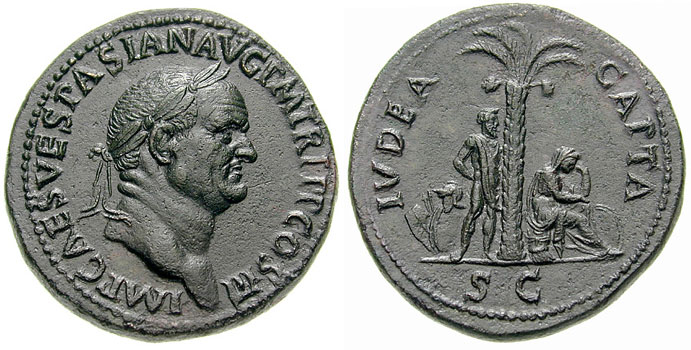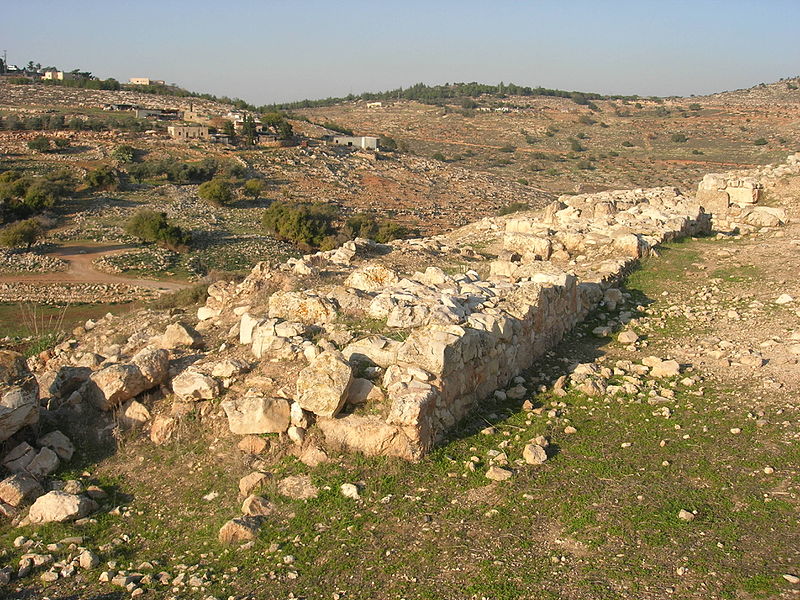If you are a regular reader of this blog or have ever done any reading about the first century Land of Israel (other than the New Testament itself) chances are you will have come across the name “Josephus”. His name seems to pop up incessantly both in scholarly literature and in popular books on early Christianity, ancient Judaism and, of course, the historical Jesus. So who exactly was Josephus and why is he so crucial to our understanding of the roots of Christianity?

A Roman coin from 71 CE bearing the bust of the Emperor Vespasian, the founder of the Flavian dynasty under which Josephus was promoted to the position of imperial historian on Jewish affairs. The coin bears the inscription IMP CAES VESPASIAN AVG P M TR P P P COS III. On the other side the inscription reads IVDEA CAPTA, S C. This is known as a “Judea Capta” coin because it depicts two Jewish captives – a man and woman – mourning the destruction of Jerusalem in 70.
The first thing that you need to know about Josephus is that his name was not really Josephus. He would have been known to his contemporaries as יוסף בן מתיתיהו or Yossef ben Matityahu (Hebrew for “Joseph the son of Matthew”). Both his own name (Joseph) and that of his father (Matthew) were extremely common among Jews in the Land of Israel in his lifetime. It was only much later that he was given the Latin name “Flavius Josephus” by his Roman patron, the Emperor Vespasian.
Born in Jerusalem in the year 37, Josephus was a member of the elite priestly class that served in the Temple. By the time he died in Rome around the year 100, the Temple was no longer standing and Judaism and Christianity had become two distinctive religions. Josephus wore many hats throughout his long life – priest, general, orator, politician – but it is due to his historical writings that he is most important to us today. His books, the Jewish War and the Jewish Antiquities are our main source of historical information concerning the centuries between the Old and New Testaments. How did he become such an important author?

Jotapata where Josephus was captured by the Romans in 67.
Josephus served as one of the highest ranking generals in the Great Jewish Revolt against the Romans (66-70). He was in command of the entire northern offensive against the Romans, focused around the region of Galilee. In the year 67 in a crucial battle at the city of Yodfat (Iodapata), his forces were surrounded by a Roman siege and all decided to kill themselves rather than surrender. Josephus was the only member of the rebel force who ended up not committing suicide; he was captured and imprisioned by the Romans.

A 12th century Latin manuscript of Josephus’ The Jewish War, housed today in the Cologne Dombibliothek.
Luckily, his life was spared, mostly due to his charm and his aristocracy. He convinced his Roman captor – the general Vespasian – that the latter would soon be promoted from a military commander to the Emperor. Fortuitously, Josephus’ prophecy was fulfilled two years later, and Vespasian did not forget him. Josephus was freed, granted Roman citizenship and given a new name that reflected his status as an imperial protege: Josephus Flavius, after the Flavian dynasty of emperors. Realizing how highly educated Joseph was, the Romans employed him to serve as a kind of public relations expert. His task was to write the proceedings of the Great Revolt as reflected through a strong pro-Roman lens. Why did the Romans bother commissioning this work? They wanted to demonstrate for posterity that they had no choice but to destroy Jerusalem. They were not barbaric tyrants who burned down the magnificent Temple of King Herod for no reason. Rather, they were pushed to the edge by the irresponsible actions of the most radical Jewish rebels, the Zealots. The Flavians felt they needed to “rebrand” the events of 66-70. Evidently, they felt rather uncomfortable with what had transpired in Jerusalem, given the international fame that the city had acquired over the previous few decades.

Title page of a German edition of Josephus’ The Jewish War published in 1552. The title reads: “Jüdische Chronic. Von großmechtiger erhöhung des Judenthumbs Königreich und Fürstenthumb.”
Josephus was given access to the finest Roman archives and did what he was told. The result is a work known as The Jewish War, a survey of the years 170 BCE – 75 CE, organized into seven books. Josephus likely wrote it in Aramic and it was later translated into Greek, the language of literature and culture throughout the eastern parts Roman Empire. This work is absolutely indispensable for reconstructing the history of first century Israel. Josephus does not just describe the events of the revolt itself, but the political and cultural background. For example, in Book 5 he describes the building projects of King Herod in Jerusalem in great detail. Without this source, archaeologists would be doing a great deal of guessing about the contents of their discoveries. Virtually every detail of this well-known model of Jerusalem in the late Second Temple Period by Prof. Michael Avi-Yonah is drawn from the writings of Josephus.

Although some of the details are no longer accepted by modern archaeologists, this 1966 model of first century Jerusalem found at the Israel Museum is still a very useful tool for understanding the appearance of the Herodian city as described by Josephus. It was formerly known as the Holyland Model because it was located on the grounds of a hotel called Holyland. In 2006 it was moved to the campus of the Israel Museum in central Jerusalem.
It has been said that 99% of the literature produced in the ancient world did not make it to the present. These thousands of lost works were either willfully destroyed or simply forgotten. If an ancient book was not recopied every now and then, the paper would eventually wither away, and the book would expire. Imagine, for example, the hundreds of thousands of scrolls – geography, history, philosophy, drama, literature – contained in the famous Library of Alexandria which were burned in the year 391. We will never know what these works contained. The big question is why did the works of Josephus survive the ravages of time and make it to the present? It would have been very easy for a rather esoteric description of a revolt in Judea to have been forgotten, not having been recopied and eventually to have expired.
The answer is quite likely due to a single paragraph which Josephus had the good fortune to write. In book 18 of The Jewish Antiquities, in the course of describing the events of the first decades of the first century, Josephus briefly pauses to mention a popular prophet in the Galilee known as Jesus. Here is what he writes:
Around this time there lived Jesus, a wise man, if indeed one ought to call him a man. For he was one who did surprising deeds, and a teacher of such people as accept the truth gladly. He won over many Jews and many of the Greeks. He was the Messiah. When Pilate upon hearing him accused by men of the highest standing among us, had condemned him to be crucified, those who in the first place came to love him did not give up their affection for him, for on the third day he appeared to them restored to life. The prophets of God had prophesied this and countless other marvelous things about him. And the tribe of the Christians, named after him, have still to this day not died out.
This passage is the most famous first century reference to Jesus outside the Gospels. It is known as the Testimonium Flavianum which means the “testimony of Josephus” in Latin. European Christians in the Middle Ages regarded this passage as the “testimony” or “witness” of an authentic Jewish contemporary of Jesus to the truth of his messianism. Monks in European monasteries copied all of Josephus’ writings over and over due to the Testimonium Flavianum. Many modern scholars debate the authenticity of the passage. Did he really write this or was it invented by the Christian monks who copied his works? Many think Josephus really did write about Jesus, but only mentioned him as a popular teacher who was crucified. As time went on and the passage became more famous, it was doctored by the Christian copyists, who added the odd references to Jesus’ divinity and messianism. Below you can see the same passage with the disputed interpolations underlined.
Around this time there lived Jesus, a wise man, if indeed one ought to call him a man. For he was one who did surprising deeds, and a teacher of such people as accept the truth gladly. He won over many Jews and many of the Greeks. He was the Messiah. When Pilate upon hearing him accused by men of the highest standing among us, had condemned him to be crucified, those who in the first place came to love him did not give up their affection for him, for on the third day he appeared to them restored to life. The prophets of God had prophesied this and countless other marvelous things about him. And the tribe of the Christians, named after him, have still to this day not died out.
The issue of the historicity of this passage is a complex one which has been discussed ad nauseum by modern scholars since the 18th century. We will not be able to settle the matter here! Suffice it to say: there is no doubt that were it not for this short paragraph, Josephus’ massive corpus of writings might never have been copied at all and we not know much of anything about the period leading up to the ministry of Jesus of Nazareth.






Join the conversation (No comments yet)